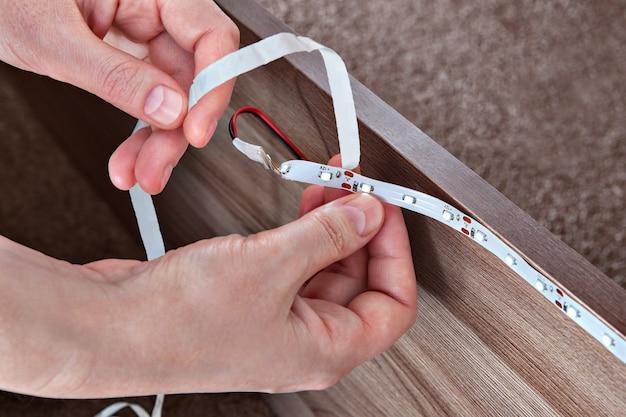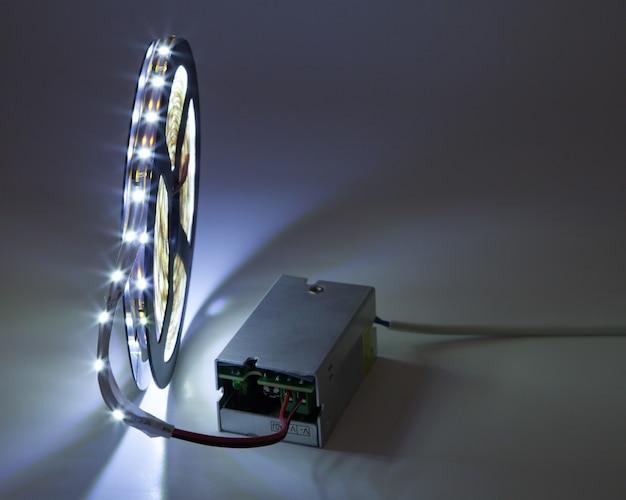LED strip lights have become a popular choice for adding ambiance and lighting effects to various spaces. However, when it comes to installing these lights, one important consideration is the size of wire to use. The right wire gauge is crucial for ensuring safety, efficiency, and proper functionality of your LED lights.
In this comprehensive guide, we will address the common questions and concerns about wire sizes for LED strip lights. We will explore topics such as the suitable wire gauge for different applications, the difference between 12V and 24V LED lights, and whether you can use 14 gauge wire for LED lights. By the end, you’ll have a clear understanding of what gauge wire to use for your LED strip lighting project.
So, whether you’re a DIY enthusiast or a professional installer, let’s dive into the world of wire gauges and LED strip lights to ensure you have the right setup for your illumination needs in 2023.
What Size Wire is Best for Your LED Strip Lights
When it comes to setting up your LED strip lights, choosing the right wire size is crucial – like finding the perfect slice of pizza after a long day. After all, you don’t want your lights to flicker like a bad disco dancer or end up with wires that resemble spaghetti on your ceiling. Fear not, dear reader! In this guide, we’ll dive into the mesmerizing world of wire sizes for LED strip lights and help you find the perfect fit for your illuminating needs.
Understanding Wire Gauges: Getting Down to the Numbers
Like choosing the right golf club for your swing, wire sizes are measured in a perplexing unit of measurement called “gauge.” The gauge of a wire determines its thickness, with lower numbers representing thicker wires. Think of it as selecting the right brush for your artistic masterpiece – you want a wire that can handle the current and power required for your LED strip lights without becoming a Picasso-esque mess.
Wire Gauges Made Simple: Deciphering the Code
Now, let’s break down the wire sizes like we would break down a nerdy math joke. When it comes to LED strip lights, the most commonly used wire gauges are 18 AWG, 20 AWG, and 22 AWG. Think of AWG as the secret language of electricians – the code they use to ensure your lights shine as bright as a supernova.
18 AWG: The Thick-But-Not-Too-Thick Wire
If you’re looking for a wire that can handle a heftier load, 18 AWG is your knight in shining armor. It’s like Superman – strong and capable of carrying larger amounts of current without breaking a sweat. This wire is ideal for longer LED strip light runs or those power-hungry installations that make your living room look like a futuristic spaceship.
20 AWG: The Middle Child Wire
Ah, the ever-versatile 20 AWG wire. It’s like the middle child of wire sizes – often overlooked but always reliable. This wire strikes a balance between thickness and flexibility, making it suitable for a wide range of LED strip light setups. Whether you’re illuminating your kitchen cabinets or adding a pop of color to your bedroom, 20 AWG will do the trick without hogging all the limelight.
22 AWG: The Thin, but Mighty Wire
They say big things come in small packages, and the same goes for the 22 AWG wire. This wire is as slender as a supermodel’s waistline but packs a surprising punch. It might not handle heavy loads like its thicker siblings, but it’s perfect for shorter LED strip light runs or projects where space is at a premium. So, if you’re illuminating your bookshelf or crafting a DIY lighting installation, 22 AWG will be your trusty sidekick.
Conclusion: Choosing the Perfect Wire Size for LED Strip Lights
Like finding the perfect rhythm for your dance moves, selecting the right wire size for your LED strip lights is crucial for a flawless performance. Remember, 18 AWG takes the spotlight for hefty setups, while 20 AWG shines in a wide range of applications, and 22 AWG dazzles in smaller, space-constrained projects. So go forth, fellow light enthusiasts, and may your LED strip lights glow bright like a starry night sky.
FAQ: What Size Wire Should I Use for LED Strip Lights
Are you feeling wired up trying to figure out the right wire size for your LED strip lights? Don’t worry, we’ve got you covered! Check out our FAQ section below for all the answers to your burning questions.
Q: What Gauge Wire Should I Use for LED Lights
A: The wire gauge you should use for LED lights depends on the power requirements of your specific setup. As a general rule, 20-gauge wire is suitable for most low-power LED applications. However, for longer LED strip runs or higher wattages, it’s better to opt for a thicker wire, such as 18 or 16 gauge.
Q: Can I Use 18 Gauge Wire for Lights
A: Absolutely! 18-gauge wire is a great choice for LED lights, especially if you’re dealing with shorter runs and lower wattages. It provides sufficient electrical conductivity without being too bulky.
Q: Is 12 Gauge Wire Always Yellow
A: No, wire color is not directly related to its gauge. While commonly available 12-gauge wire is often yellow, it can also come in different colors, such as white or black. Be sure to check the labeling and markings on the wire to determine its gauge, rather than relying solely on the color.
Q: Can You Run a 14 Gauge Wire off a 12 Gauge Wire
A: As long as the 12-gauge wire can handle the overall load, it is generally safe to run a 14-gauge wire off of it. However, it’s important to consult local electrical codes and consider factors such as distance and total amperage before making any connections.
Q: What is the Maximum Amperage for 14 Gauge Wire
A: The maximum amperage for 14-gauge wire is typically around 15 amps for household wiring. However, it’s always a good idea to consult local electrical codes and consider the specific application, as there may be variations based on regional regulations.
Q: What is Better: 12V or 24V LED Lights
A: The choice between 12V and 24V LED lights depends on your specific requirements. 12V LED lights are commonly used in automotive, marine, and RV applications, while 24V LED lights are more popular for commercial and outdoor lighting. Consider your power source and lighting needs to determine which voltage is better for you.
Q: How Do I Know What Gauge Wire to Use
A: To determine the appropriate wire gauge for your LED lights, you need to consider the total wattage, length of the wire run, and the voltage drop you’re willing to tolerate. You can refer to online voltage drop calculators or consult an electrician for a more precise recommendation based on your setup.
Q: Should I Use 12 or 14 Gauge Wire Outlet
A: The choice between 12 and 14 gauge wire for your outlet depends on the amperage requirements of the connected devices. For standard household outlets and most appliances, 12-gauge wire is the safer bet as it can handle higher current loads. However, if you’re only powering smaller devices, 14-gauge wire can be sufficient.
Q: Can I Use 14 Gauge Wire for LED Lights
A: Certainly! 14-gauge wire is commonly used for LED lights, particularly in shorter runs and lower wattage applications. It provides good conductivity and is easier to work with compared to thicker wires, making it a popular choice among DIY enthusiasts.
Q: Can 14/2 Wire Be Used for Lights
A: Yes, 14/2 wire can be used for lights. The “14/2” designation indicates that it is a 14-gauge wire with two insulated conductors, typically used for general lighting. However, always ensure that the wire you choose meets your specific electrical requirements and complies with local building codes.
Q: What Gauge Wire Do I Need for 12V
A: The gauge wire you need for a 12V system depends on the current load and length of the wire run. As a general guideline, 16-gauge wire is suitable for most 12V applications with shorter wire runs, while 14-gauge wire is recommended for longer runs or higher currents.
Q: Is All 18 Gauge Wire the Same
A: Not all 18-gauge wire is created equal! Different types of wire, such as solid or stranded, have varying ampacity and electrical characteristics. Always check the specifications and intended use of the wire to ensure it meets your specific requirements.
Q: What is the Difference Between 12/2 and 12/3 Wire
A: The numbers in the wire designation refer to the gauge and the number of conductors, respectively. In the case of 12/2 wire, it indicates a 12-gauge wire with two insulated conductors and a bare ground wire. On the other hand, 12/3 wire has three insulated conductors – commonly used for applications requiring multiple circuits or features such as three-way switches.
Q: What Gauge Wire Do I Need for 12 Volt
A: For a 12V system, the appropriate wire gauge depends on the current load and length of the wire run. As a general guideline, 16-gauge wire is suitable for most 12V applications with shorter wire runs, while 14-gauge wire is recommended for longer runs or higher currents.
Q: Can You Connect 12V to 24V LED Lights
A: No, it’s not advisable to connect 12V and 24V LED lights directly. The voltage disparity can damage the lower voltage lights and potentially cause hazards. Make sure to use the correct voltage power supply or consult an electrician to properly step up or step down the voltage.
Q: Can I Use Speaker Wire for 12V LED Lights
A: In a pinch, you can use speaker wire for 12V LED lights, especially for shorter runs. However, keep in mind that speaker wire is not specifically designed for electrical wiring purposes. It’s always best to use wire specifically intended for low voltage lighting to ensure optimal performance and safety.
Q: What is the Difference Between 12V and 24V LED Lights
A: The main difference between 12V and 24V LED lights lies in their operating voltage. 12V LED lights are typically found in automotive, marine, and low-power applications, while 24V LED lights are commonly used in commercial and outdoor lighting setups. The choice depends on your specific needs and power requirements.
Q: Can You Connect 18 Gauge Wire to 12 Gauge Wire
A: Connecting 18 gauge wire to 12 gauge wire is possible, but it’s important to consider the overall load and consult local electrical codes. If the 12 gauge wire can handle the combined load, you can make the connection using appropriate connectors or wire nuts.
Q: Can I Use 12 Gauge Wire for LED Lights
A: While 12 gauge wire can handle higher current loads, it is not necessary for most LED lighting applications. Unless you are dealing with an extensive LED setup with longer runs and high wattages, you can generally use smaller gauge wires, such as 18 or 16 gauge, which are more convenient and easier to work with.
Q: Can You Use 16 Gauge Wire for LED Lights
A: Yes, you can use 16 gauge wire for LED lights, especially for shorter runs and lower wattages. It provides sufficient conductivity and is easier to work with compared to thicker wires. Just ensure that the wire is appropriate for your specific LED setup and meets any applicable electrical codes.
Q: Can You Use 24V Lights on 12V
A: No, it is not safe to use 24V lights on a 12V circuit. The voltage mismatch can lead to damages and potential hazards. Always ensure that the voltage of your lights matches the voltage output of your power supply to maintain proper functionality and safety.
Now that you’re equipped with wire knowledge, you’ll be electrifying your LED strip light setup like a pro! Remember to double-check your specific requirements and consult local electrical codes for any additional guidelines. Happy lighting!

